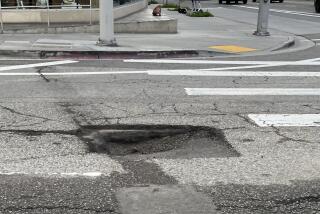On board with the mayor
- Share via
It sometimes seems as if
Mayor Antonio Villaraigosa sheds ideas the way a Roman candle does sparks, but none has ignited quite the fire he’s started with his 30/10 proposal. It’s a blaze whose flames now deserve to be fanned by the rest of the local and state political establishment -- in both parties.
Essentially, the mayor is proposing what federal officials are calling a “big bang” transit construction program that would simultaneously address both Los Angeles County’s grinding congestion problems and its desperate unemployment crisis.
Villaraigosa starts with last year’s passage of Measure R, which added half a cent to the sales tax for the next 30 years. The $40 billion raised by
that increase will go to fund 12 high-impact mass-transit projects -- including the so-called Subway to the Sea under Wilshire Boulevard -- and a variety of congestion relief efforts. Rather than stretching the construction program out over three decades, the mayor wants Washington to advance the Metropolitan Transportation Authority the money now as a kind of bridge loan, accepting the future Measure R tax revenues as a guarantee of repayment.
Not only would Los Angeles County get a dramatically expanded public transit system in just 10 years, but the projects would create 165,000 construction jobs -- unemployment in that sector currently approaches 40% -- and another 2,500 permanent transportation-related positions.
When the Department of Transportation made one of its “outreach” visits to Los Angeles a couple of weeks ago, the mayor’s proposal won powerful allies in Sen. Barbara Boxer
(D-Calif.), Secretary of Transportation Ray LaHood, Rep. Peter A. DeFazio (D-Ore.), chairman of the House Highways and Transit subcommittee, and Rep. James L. Oberstar (D-Minn.), chairman of the House Committee on Transportation and Infrastructure. All came away from their talks with the mayor endorsing 30/10.
This week, Boxer, who calls support for the proposal a no-brainer, invited Villaraigosa back to testify before the Senate Committee on Environment and Public Works, which she chairs. She came away impressed.
“First, we all want to reward local governments that have taken the kind of steps toward self-help Los Angeles has,” Boxer said. “Second, coming out of this recession, this proposal will create jobs in one of our heaviest-hit sectors, heavy construction. Third, by funding these projects now, when the recession has pushed down construction costs, we can save as much as 20% on their total cost.”
Boxer asked Villaraigosa to identify which of the projects were “shovel ready,” and he pointed to the extensions of the light-rail Gold Line in the San Gabriel Valley and the Orange Line busway in the San Fernando Valley. The senator said she and LaHood would be working together to obtain immediate funding for both. She also said she and other congressional supporters would work to provide the rest of the funding in this year’s transportation bill.
Aside from the obvious benefits -- a dramatically stepped-up attack on congestion and the creation of desperately needed construction jobs in a period of intense economic distress -- adoption of Villaraigosa’s 30/10 plan would be a giant step toward depoliticizing Los Angeles County’s transit debates. Transit decisions inevitably have a political dimension, but ever since the hysterical overreaction to the 1985 methane explosion at Third and Fairfax derailed plans for the Wilshire subway line, our decisions on transit routes have been essentially political.
Pushing forward with 30/10 would relegate the political component of our transit debates to a normal level because, over the next decade, MTA would be able to simultaneously proceed with a Wilshire subway to the sea, with eastward extensions of the Gold Line across both the northern and southern sections of the San Gabriel Valley, a pair of Green Line branches, light rail to the Westside and along Crenshaw Boulevard, as well as vital downtown and other connecting lines within the existing system, critically needed busways across the San Fernando Valley and a multiple-occupancy vehicle lane along the 405 Freeway.
Another way to consider it is this: As important as it is, over the next decade Measure R will produce only about $3 billion for mass-transit construction, or roughly enough to fund the first leg of the subway extension westward under Wilshire. That project would benefit a fraction of the city’s 4 million residents. If the mayor’s 30/10 proposal is adopted, the entire county’s 10 million people will enjoy the benefits of all the projects listed above by 2010. That alone would go a great distance toward eliminating the beggar-your-neighbor impulse that has dominated our transit discussions over these past years.
More to Read
Sign up for Essential California
The most important California stories and recommendations in your inbox every morning.
You may occasionally receive promotional content from the Los Angeles Times.













